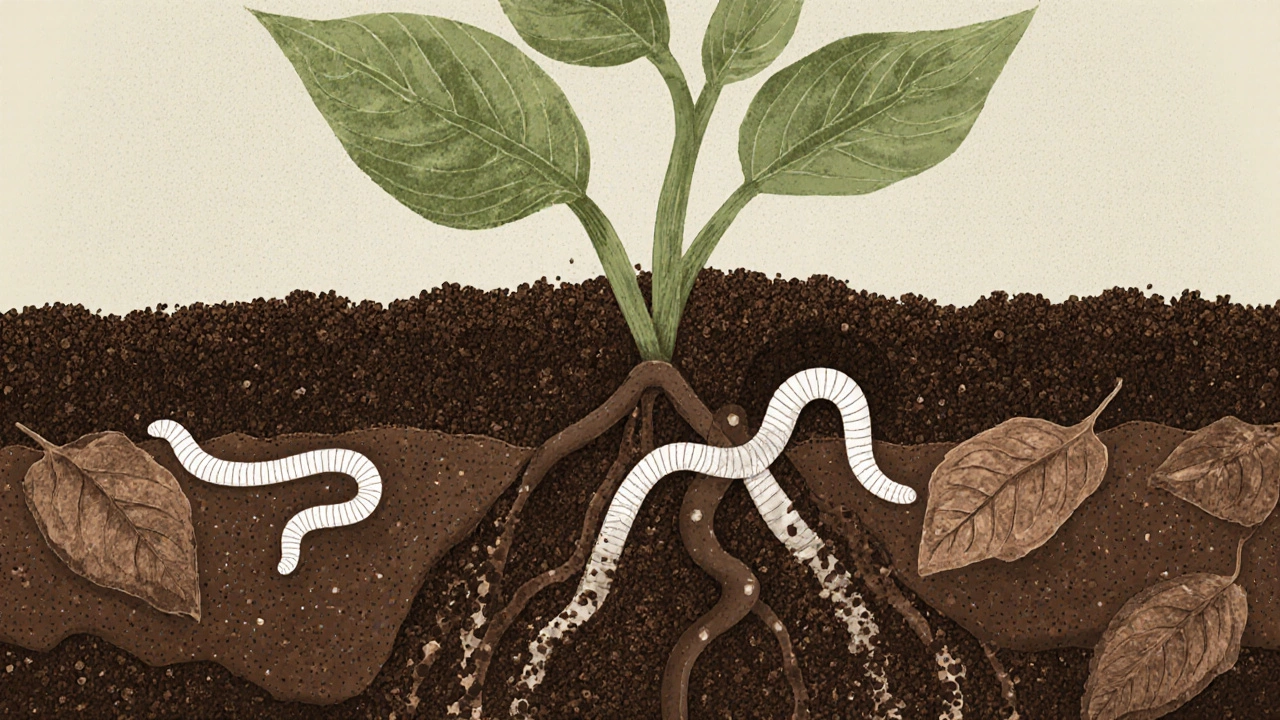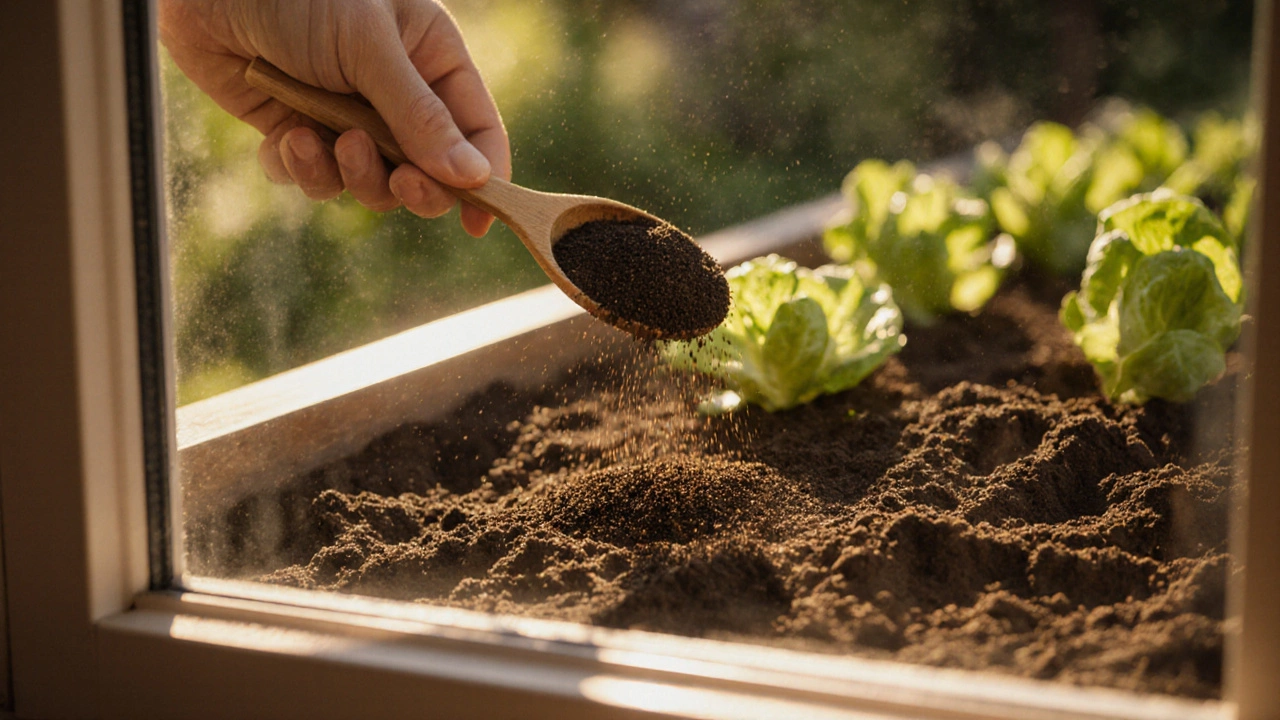Coffee Grounds Garden Calculator
You've just brewed a fresh pot and wonder if the leftover coffee grounds are the dark, slightly gritty residue left after extracting coffee beans can double as a garden booster. The short answer: yes, but only if you know how they work in the soil and apply them the right way.
Key Takeaways
- Coffee grounds add organic matter and a modest amount of nitrogen to soil.
- They are mildly acidic; use them sparingly on alkaline soils.
- Mixing grounds with compost or mulch speeds up decomposition and avoids nitrogen lock‑up.
- Avoid thick layers; thin sprinklings prevent mold and discourage pests.
- Combining grounds with earthworms creates a thriving micro‑ecosystem.
What Exactly Are Coffee Grounds?
When you brew a cup, the water pulls out soluble compounds from the beans, leaving behind a compacted mass of coffee grounds mostly cellulose, lignin, and a tiny amount of remaining caffeine. By weight, they’re about 2‑3% nitrogen, 50% carbon, and contain trace minerals like potassium and magnesium.
How Coffee Grounds Impact Soil
The soil you work with is a living matrix of minerals, organic matter, water, and organisms. Adding any amendment changes this balance.
Soil is a mixture of mineral particles, organic material, air, and water that supports plant growth benefits from organic inputs because they improve structure, water retention, and nutrient availability. Coffee grounds contribute three main effects:
- Organic matter: The carbon‑rich fibers become food for microbes, loosening compacted soil over time.
- Nitrogen boost: Though low in absolute nitrogen, grounds supply a quick‑release source that fuels microbial activity.
- Acidity: Fresh grounds sit around pH 6.5‑6.8, slightly acidic, which can lower the pH of alkaline beds.

When Acidity Matters
Many garden plants thrive in neutral to slightly acidic conditions (pH 6.0‑7.0). If your garden soil is already acidic, adding more coffee grounds could stunt growth. A simple home test-mix soil with water, let it settle, and compare the color to a pH chart-helps you decide.
For those with high‑pH soils (often chalky soils in parts of the UK), a thin sprinkle of grounds can gently bring the pH down, making nutrients more accessible.
Benefits of Using Coffee Grounds
Beyond nutrients, coffee grounds offer practical perks:
- Improved texture: Fine particles fill gaps in heavy clay, enhancing drainage.
- Moisture retention: The grounds act like a sponge, holding water close to roots.
- Worm attraction: Earthworms love the organic matter; their castings further enrich the soil.
- Weed suppression: A light mulch layer blocks light, reducing weed germination.
- Recycling: Using spent grounds cuts waste and saves money on commercial mulches.
Earthworms are soil-dwelling organisms that ingest organic material and excrete nutrient‑rich castings thrive on coffee grounds, turning them into even richer soil. A garden buzzing with worms usually means healthier plants.
Potential Drawbacks and How to Avoid Them
While coffee grounds are handy, they’re not a cure‑all. Common pitfalls include:
- Excessive nitrogen lock‑up: If you pile grounds too thick, microbes may consume existing soil nitrogen to break down the carbon, temporarily starving plants.
- Mold growth: A soggy, dense layer can foster mold, which might look unsightly and could attract pests.
- Caffeine residue: Rarely, high caffeine levels can inhibit seed germination; most commercial beans have minimal remaining caffeine after brewing.
Mitigation is simple: thinly sprinkle grounds, mix them into compost, or combine with other mulches.
Best Practices for Application
Follow these steps to get the most out of your grounds:
- Let the grounds dry for a few hours; wet grounds clump together.
- Spread a layer no thicker than a quarter inch (about 0.6cm) over the soil surface.
- Gently rake the layer into the top 2‑3cm of soil, or mix into an existing compost heap.
- Water lightly afterward to kick‑start microbial activity.
- Repeat every 4‑6 weeks during the growing season.
For raised beds, blend one part grounds with two parts leaf mold or shredded newspaper before adding to the soil mix. This balances the carbon‑to‑nitrogen ratio to roughly 30:1, ideal for decomposition.

Comparison: Coffee Grounds vs. Other Organic Mulches
| Mulch Type | Nitrogen Content | pH Effect | Decomposition Speed | Best Use |
|---|---|---|---|---|
| Coffee Grounds | 2‑3% (moderate) | Mildly acidic (pH 6.5‑6.8) | Fast (weeks) | Top‑dressing, compost boost |
| Leaf Mold | Very low | Neutral to slightly acidic | Slow (months) | Long‑term soil conditioner |
| Compost | Varies (5‑6% typical) | Depends on inputs, usually neutral | Moderate (1‑3 months) | All‑purpose amendment |
| Manure | High (up to 2‑3% N) | Often neutral | Moderate to fast (weeks‑months) | Heavy feeders, fruiting plants |
Notice that coffee grounds deliver quick nitrogen and acidity, making them a handy companion for acid‑loving veggies like blueberries or azaleas. Pairing them with slower‑decomposing mulches balances nutrient release.
Common Questions About Coffee Grounds in the Garden
Frequently Asked Questions
Can coffee grounds replace compost?
No. Coffee grounds are a great supplement, but they lack the balanced nutrient profile of finished compost. Use them to boost compost piles, not as a sole amendment.
Will coffee grounds attract pests?
A thin, dry layer rarely attracts pests. Problems arise only when grounds stay wet and form a thick mat, which can lure slugs or mold‑loving insects.
Are there plants that dislike coffee grounds?
Plants preferring alkaline soil-like lavender, rosemary, and many Mediterranean herbs-may suffer if you over‑apply acidic grounds. Keep the layer thin or mix with lime.
How much coffee grounds can I use per square meter?
About 250‑300grams of dry grounds spread thinly per square meter works well. Adjust based on soil test results.
Do caffeine residues harm seedlings?
Caffeine levels in spent grounds are usually low enough not to affect most seedlings. If you notice stunted germination, reduce the application amount.
Next Steps for the Curious Gardener
If you’ve just finished your morning brew, start a small trial patch. Sprinkle a thin layer, mix in a handful of leaf litter, and monitor plant response over a month. Record any changes in leaf colour, growth speed, or weed presence. This hands‑on experiment will show you the real impact in your own garden micro‑climate.
Remember, coffee grounds are a resource, not a miracle cure. Used wisely, they enhance soil life, improve structure, and close the loop on kitchen waste. Sprinkle smart, mix well, and watch your garden thank you.
